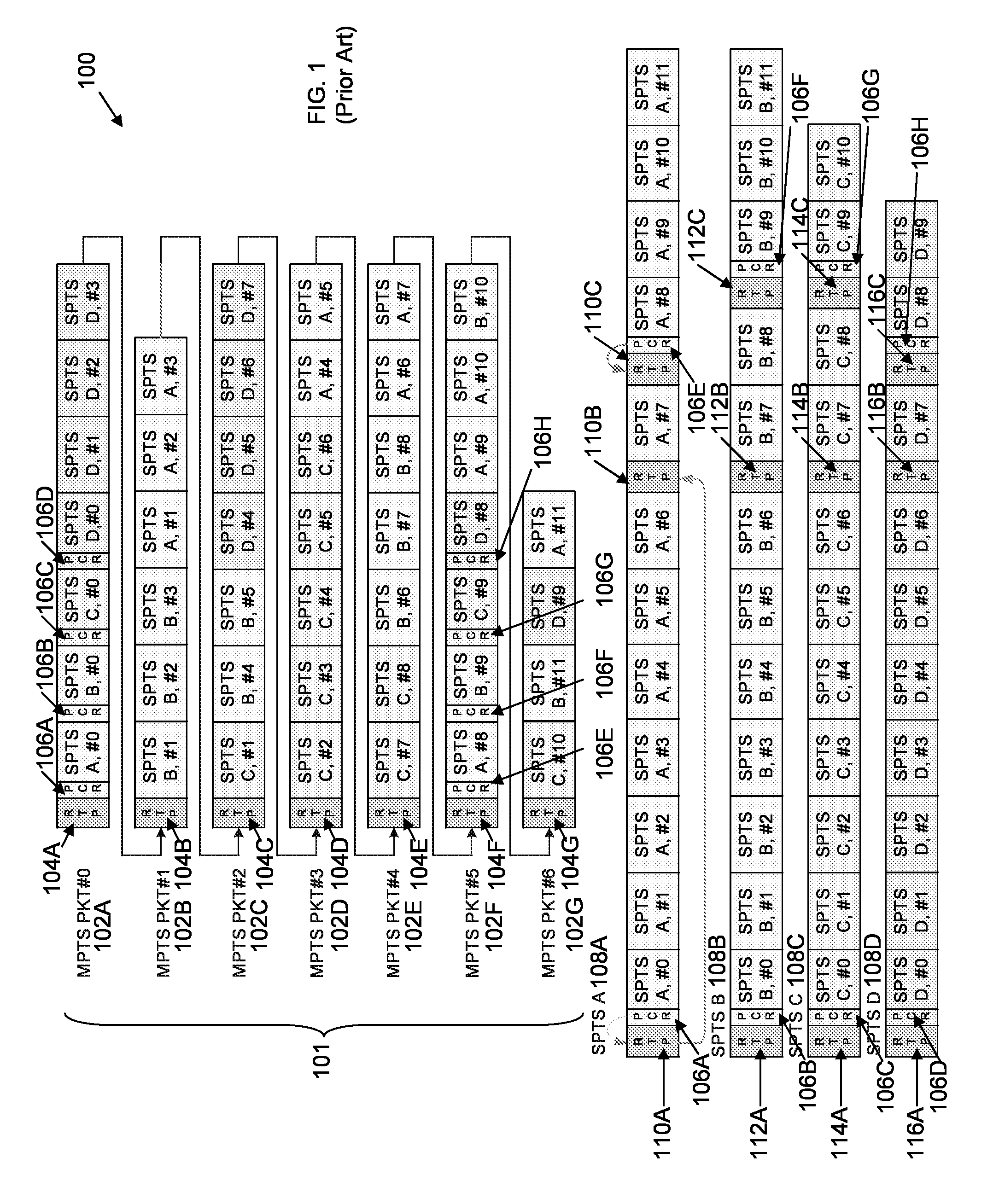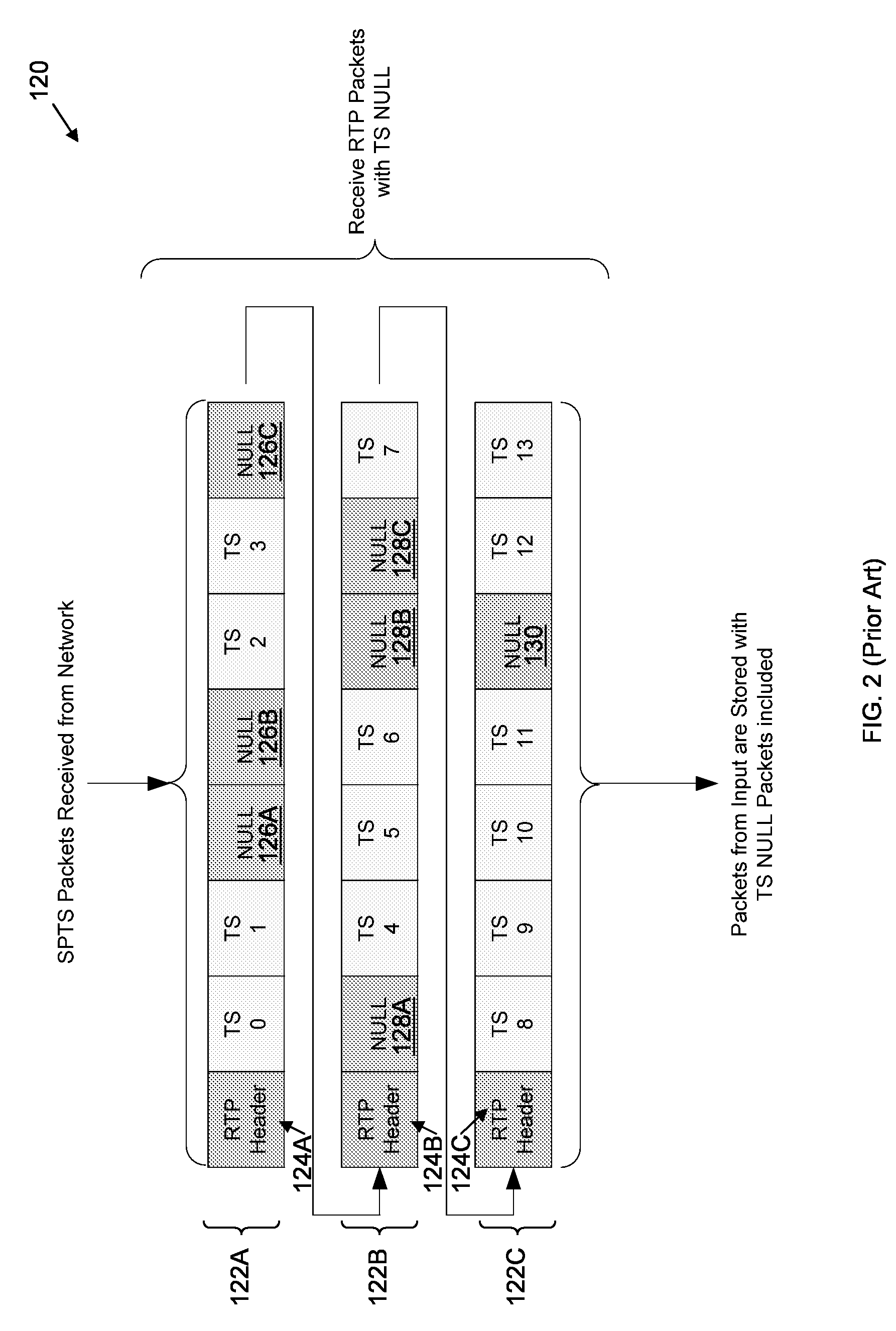Efficiently storing transport streams
a transport stream and stream technology, applied in the field of efficient storage of transport streams, can solve the problems of data loss, inability to associate with any particular spt, and overfilling of the decoder buffer, so as to reduce complexity and processing, facilitate preprocessing the transport stream, and efficiently store the effect of transport streams
- Summary
- Abstract
- Description
- Claims
- Application Information
AI Technical Summary
Benefits of technology
Problems solved by technology
Method used
Image
Examples
first embodiment
[0064]FIG. 6A is a diagram showing an internal packet header 180 for an internal packet format according to a The internal packet header 180 includes a type field 182, a Res (i.e., reserved) field 184, a Start of Packet (S) field 186, an End of Packet (E) field 188, and a Discontinuity (D) field 190. The internal packet header 180 includes a reserved field 192, a NULL Pkt Mask field 194, a packet length field 196, and a timestamp 198. The Res field 184 is a 2-bit reserved field. The reserved field 192 is a 7-bit reserved field.
[0065]The internal packet format (e.g., defined by internal packet header 180) allows for the creation of variable length packets, indicated by the S field 186 (i.e., the start), the E field 188 (i.e., the end), and the packet length field 196, as well as up to seven MPEG-2 TS Null Packets. The internal packet format consists of the fixed size internal packet header 180 (e.g., 8-bytes), and generally a payload, although a payload is not required in all instan...
second embodiment
[0079]FIG. 9A is a diagram showing an internal packet header 270 for an internal packet format according to a The internal packet header 270 includes a type field 272, a Res (i.e., reserved) field 274, a Start of Packet (S) field 276, an End of Packet (E) field 278, and a Discontinuity (D) field 280. The internal packet header 270 includes a reserved field 282, a TS Pkts field 284, a packet length field 286, and a timestamp 288. The TS Pkts field 284 indicates the number of Null packets that should be inserted at the location of the internal packet header 270 within the storage packet. For example, the internal packet format includes a NULL type, and when the type field 272 is set to NULL, the TS Pkts field 284 is checked by the delivery module 156 to determine the number of Null packets to insert into the reconstructed network packet. The TS Pkts field 284 is a 3-bit field, with a value range of zero to seven. The packet length field 286 indicates the distance to the next internal...
third embodiment
[0089]FIG. 12 is a diagram 400 showing the use of internal packet header 270 of FIG. 9A for storing network packet 402 according to a Network packet 402 includes network encapsulations 404, including 802.3 Header 404A, virtual local area network (VLAN) header 404B, IP header 404C, user datagram protocol (UDP) header 404D, and RTP header 404E. Network packet 402 includes seven TS packets 406, including TS 0, TS 1, TS 2, Null 406A, Null 406B, TS 3, and TS 4. Internal packet 408 includes an 8-byte internal packet header 410, TS packets TS 0 through TS 4, and a Null packet header 412 (e.g., an instance of internal packet header 270 of FIG. 9A). Packet header 410 can be an internal packet header 180. For example, the type field 182 is set to indicate that packet header 410 is the internal packet header and does not include information regarding null packets (e.g., depending on the value the type field 182 is set to, the NULL Pkt Mask 194 may or may not be valid).
[0090]Referencing method...
PUM
 Login to View More
Login to View More Abstract
Description
Claims
Application Information
 Login to View More
Login to View More - R&D
- Intellectual Property
- Life Sciences
- Materials
- Tech Scout
- Unparalleled Data Quality
- Higher Quality Content
- 60% Fewer Hallucinations
Browse by: Latest US Patents, China's latest patents, Technical Efficacy Thesaurus, Application Domain, Technology Topic, Popular Technical Reports.
© 2025 PatSnap. All rights reserved.Legal|Privacy policy|Modern Slavery Act Transparency Statement|Sitemap|About US| Contact US: help@patsnap.com



